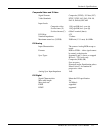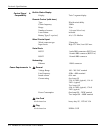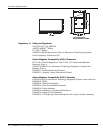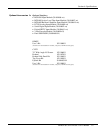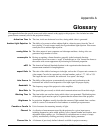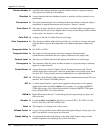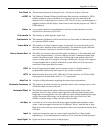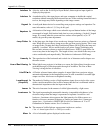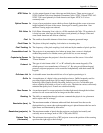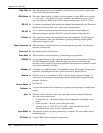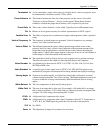
Appendix A: Glossary
RPMSP & CSP70-D100U User’s Manual A-3
The maximum frequency of the pixel clock. Also known as pixel clock rate.
The Enhanced Extended Display Identification Data standard, established by VESA,
enables properties (such as resolution) of a display device to be detected by the
display card in a controlling device such as a PC. The PC, in turn, can then output in a
matching format to fill the display. Some sources used with the projector are VESA E-
EDID reported.
A very rapid variation in image brightness caused by a frame rate that is too slow.
(See Interlace) See also Lamp Flicker.
The intensity of visible light per square foot.
The luminance (brightness) which results from one foot-candle of illumination falling
on a perfectly diffuse surface.
The frequency at which complete images are generated. For non-interlaced signals,
the frame rate is identical to the vertical frequency. For interlaced signals, the frame
rate (also known as field rate) is one half of vertical frequency.
The ability of a screen to direct incident light to an audience. A flat matte white wall
has a gain of approximately 1. Screens with gain less than 1 attenuate incident light;
screens with gain more than 1 direct more incident light to the audience but have a
narrow viewing angle. For example: An image reflecting off a 10 gain screen appears
10 times brighter than it would if reflected off a matte white wall. Curved screens
usually have larger gain than flat screens.
General Purpose Input Output, used for remote control of a limited number of
programmable functions by direct signal or dry-contact connection.
High-definition Television (1035, 1080 and 1125 lines interlace, and 720 and 1080
line progressive formats with a 16:9 (i.e. 1.77) aspect ratio.
A display of help information regarding the current task or presentation.
The frequency at which scan lines are generated, which varies amongst sources. Also
called horizontal scan rate or line rate.
The difference between the center of the projected image and the center of the
projector lens. For clarity, offset is often expressed as the maximum amount of the
image that can be projected to one side of the lens center without degrading the image
quality. Horizontal offset ranges can be affected by the type of lens in use, and
whether or not the image is offset vertically at the same time.
A circular area of a screen where the image appears brighter than elsewhere on the
screen. A hot spot appears along the line of sight and "moves" with the line of sight.
High gain screens and rear screens designed for slide or movie projection usually have
a hot spot.
A physical connection route for a source signal, described by a 2-digit number
representing 1) its switcher/projector location and 2) its slot in the switcher/projector.
Signal sent from a source device to the projector.
Dot Clock
'
E
-EDID '
Flicker '
Foo
t
-candle '
Foo
t
-lamber
t
'
Frame Rate '
Gain or Screen Gain '
GPIO '
HDT
V
'
Hel
p
Tex
t
'
Horizontal Fre
q
uenc
y
'
Horizontal Offse
t
'
Hot S
p
o
t
'
In
p
u
t
'
In
p
ut Si
g
nal '



